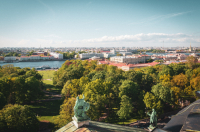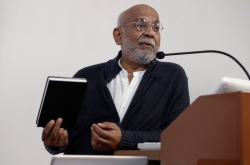The plenary discussion “The City of the Living: Culture as a History of the Future” marked the end of the business program of the III International Spatial Development Forum that took place in St. Petersburg from 27 to 29 September. Each year, the event brings together politicians, entrepreneurs and scientists involved in the various fields of planning, development and management of urban spaces. The Forum is organized by ITMO University and the Government of St. Petersburg.
The main goal of the Forum is to find effective approaches to sustainable urban development with regard to the global challenges of today’s world. This year, the main theme was the re-thinking of the cities’ essence and the evolutionary ways for their development. More than 50 speakers from Europe, Latin America, Asia, US – representatives of business, governments and NGOs, community members and activists – discussed topics relevant to smart cities, renovation and revitalization of cities, as well as the role of digital technology in their development.

Mikhail Klimovsky at ISDF-2017
As Mikhail Klimovsky, head of the Forum’s Program Committee and Urban Studies Advisor to ITMO’s Rector, notes, one of the main tasks of the event is to present various points of view on urban development that go beyond just city planning and social and economic development. The business program culminated with a session that aimed to try and redefine the future of city life through the lens of cultural development, to talk about culture as a growth driver for new environments. How does St. Petersburg live today? Is it alive or is it dead? Does it need change? How should it look in the future? These questions were discussed by the event’s participants - musician-songwriter Sergey Shnurov, journalist Alexander Nevzorov, artist and sculptor Andrey Bartenev, theatre director Semyon Alexandrovsky and founder and CEO of bookstore chain “Bookvoed” Denis Kotov.

Skyscraper evolution
The first to speak was journalist Alexander Nevzorov, who began the discussion with ruminations on the Lakhta Center skyscraper complex, which, according to him, has a few drawbacks – it is “a bit short, a bit small and lonely”. The appearance of skyscrapers in St. Petersburg is undoubtedly a good thing, which only signifies the city’s inevitable evolution; meanwhile, the obsession with historicism, the “fetishization of the old”, only stalls the city, he believes.
“I realize that, most likely, nine out of ten people here don’t agree with me; but development is an unstoppable thing,” – said Nevzorov – “There was a time, especially in the Soviet era, when St. Petersburg was justified in cherishing the old, as it appeared a counterpart to the grey, gloomy spectacle that was the Soviet construction. Back then the fetishization of old was justified and understandable. But these days there is no such need. We shouldn’t fear development and understand that, indeed, there is a postal-card-esque area that will surely remain unchanged, but there’s no reason not to have the background for that scene to be filled with massive, daring, sky-scraping beautiful buildings”.
Hermitage hearbeat

Sergey Shnurov connects live from Munich
Sergey Shnurov, who could not be present in person, joined the discussion in a live stream from Munich. In response to the question “is St. Petersburg alive or dead?” he recalled the much talked-about exhibition of Jan Fabre’s works at the Hermitage Museum.
“St. Petersburg has its “temperature” measured by the Hermitage. And it is more than alive. The exhibitions there draw the attention and ire of the public – the Fabre exhibition, for instance. The word “museum” can mean a house of inspiration and creativity or a moth-balled warehouse. Hermitage manages to successfully combine these two notions,” – said Shnurov.
He also added that St. Petersburg itself will inevitably evolve despite the traditionalists’ protests. There is no point in always looking back, said Shnurov, and the future of St. Petersburg is that of a metropolis.
Art is a weapon

Andrey Bartenev and Semyon Alexandovsky
Andrey Bartenev – a painter, sculptor and creator of provocative and interactive installations and performances – expressed his belief that any work of art created in the urban environment has the power to sway the citizens’ minds.
A famous example is the well-known broken windows theory, introduced in 1982 by James Q. Wilson and George L. Kelling, which states that in a society that tolerates small crimes, people are more likely to engage in small and major crimes. The theory had proved its merit in 90’s New York City, when Mayor Rudy Guliani took a hard stance on vandalism, panhandling, fights and subway turnstile-jumpers. These policies are said to partly account for the 50%-drop in personal crime in late 90’s.
“Art is an incredibly powerful weapon in urban environment. Even such trivial things, such as symbols on buildings, can affect our minds. Of course, changes must occur – St. Petersburg cannot remain a closed system. And when you come to terms with that idea, you can move on to stage two, where you support and help the new, growing changes. The quality of these changes, though, is another matter. Sure, you can whip up a cardboard monstrosity in the halls of the Russian Museum and proclaim it to be revolutionary and evolutionary. But St. Petersburg is a city of high quality, so let us find the compromise, the harmony in which the changes would conform to the overall context of the city’s landscape,” – said Bartenev.
A city for the readers
Denis Kotov, founder of the bookstore chain Bookvoed, disagreed with the notion of St. Petersburg as a “dead” city, referencing the book “To Live in St. Petersburg”. The compilation book is akin to a literary walk through the city in the company of today’s best Russian authors. Notable novelists, publicists, musicians, sculptors and art experts from St. Petersburg came together to express what the city means to them and how one can choose to live in it.

“This book is the number one bestseller in St. Petersburg – the city which can surely become the cultural capital of not just Europe, but perhaps the entire world. If we decide that we want that to happen, then our city’s environment will become that very museum that is not a mothballed warehouse, but a place of creativity,” – said Kotov.
The way to achieve that, he explains, is for people to change themselves, by facilitating the development of urban spaces, taking an active part in their lives, by pursuing self-development and reading the “bare minimum” of 10-12 books a year. It’s not important what you read: literary snobbery has no place here and everyone should read according to their own desires. What matters is that you develop your own way of thought.





